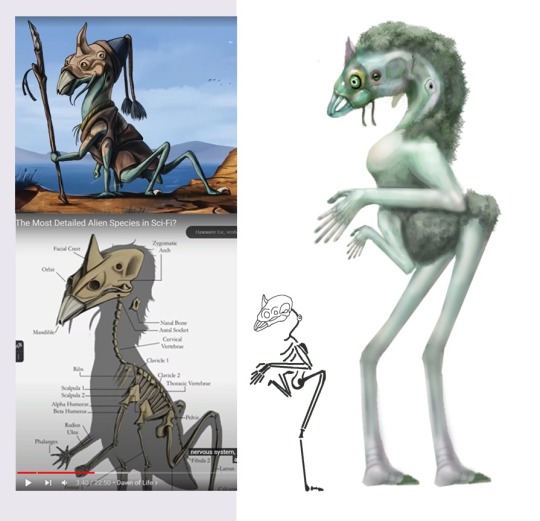Text


So, I came back. This is reconstruction of probably fist bipedal lizard-like thing - Lanthanolania ivakhnenkoikoi from permian period.
Not a very good resolution, but I will try to fix it in the following works
11 notes
·
View notes
Text
So, my fist post in Tumblr (second, but this post planned as fist). I very exited - but also scared, because everything there new and unknown. And about what I can talk there?
Snakepeople and worms art from All Tommorows!


It is very strange creatives, because mammals dont have really good body to become snake-like animals. Our spine mostly flex forward and backward, when some flexes right and left. That explains why many reptiles lost flexibility of they bodies (birds) or become a smallfoot or legless creatives. But mamalls whith small limbs moves more like cuterpillar than snakes - watch some cute seals videos, if you dont believe.


But if we talk about Snakepeople and Worms, we dont have real troubles whith that. Thy dont have some things, what mammals does. No tooth, no milk, no good human brain - maybe Worm dont even have brain hemispheres, because Snakepeople have spiral brain. So, I think Worms just have primitive amphibia spine and very simple brains or something like that, and after years of evolution they become more reptilelike than their ancestors.
I have other speculations about this posthumans too: hair tooth (for better hint), secondary marsupials birth (because is more save for mother tailarm and baby if embrio end his development in special bag on mother belly), bifurcated lower jaw (snake have flex jaws and for Snakepeople more comfortable to have arm-like structure near his eyes and head), aves tiny arms (just cute but not necessary):



What about evolution? There is my transitional posthuman for Worms and Snakepeople - an ambush forest predator, catching prey with its front hands and holding on to branches with its hind legs. Also, this creature - let's call it a Flower Hunter - has outgrowths in the form of petals, which will later lead to the appearance of Snakepeople ears. (sorry for shitty quality).

Thats all about Snakepeople. All works there is old arts from 2021, and i ready to show some more modern and intresting projects. And hey, Im that guy who made Ultimate All Tomorrows size compilation)
7 notes
·
View notes
Text

Redesign of Yaetuan from Christian Cline’s "The Yaetuan Sagas". This is not serious work, since it is necessary to study the project itself in a good way, especially the structure and evolution of these creatures. The Yaetuans are aliens who descended from hexapods with grasshopper legs behind, and had an evolution completely similar to that of humans.
Here I just satisfied my desire to correct their strange disproportion in their bodies. I wanted to keep centaurism, but something didn't go, nothing fit. So, in fact, the head was reduced and the limbs were enlarged. As a result, the resulting legs with the foot facing backwards can well explain why these creatures did not occupy the niches of ostriches or gazelles in their world (spoiler: you can't run with them much). The first limbs are enlarged, designed for confident throws of objects, and those in the middle are weakened to make room for the muscles of the arms and legs. The beak is reduced, made like tweezers, since the author of these creatures believes that the beak of Yaetuans also performs the function of manipulators (which I think is superfluous). The eyes are differentiated: some are large round to track prey and sense volume, others have an elongated pupil to inspect the area. The neck could be made thicker, because the head still comes out heavy.
In short, in the end we got almost a humanoid. And I missed the structure of the Yaetuans hand. Wasted...
Somehow, in short, in any case, it's better to redo it later and take into account all the nuances of the original project
13 notes
·
View notes